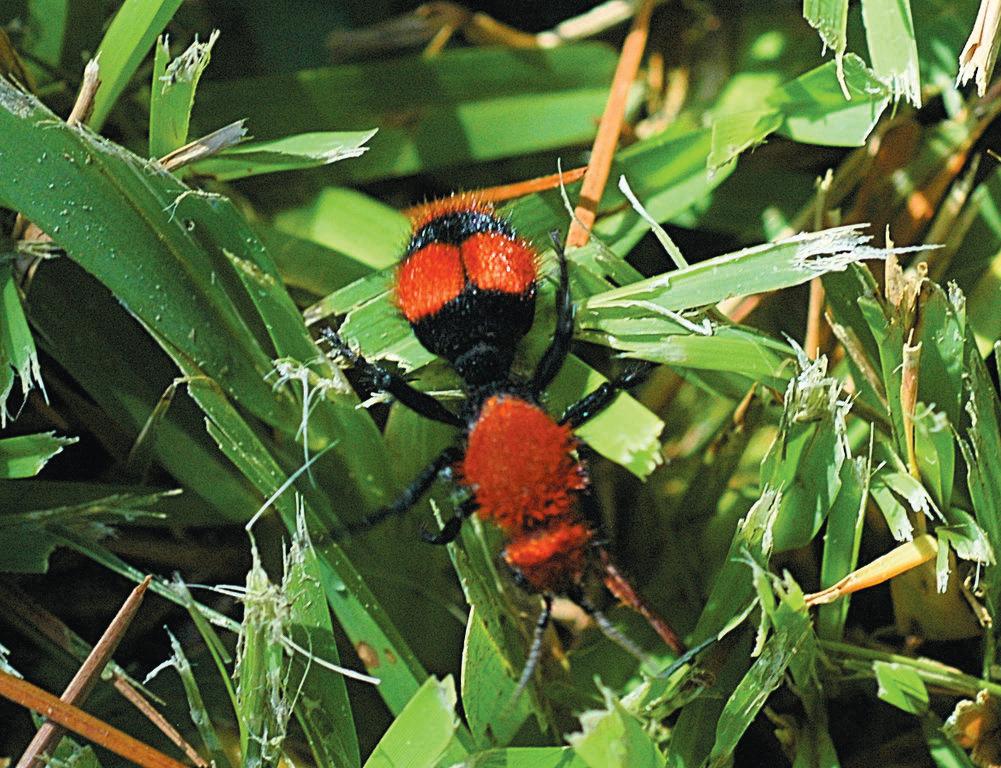
3 minute read
everything greens: velvet ants don’t touch
Everything Greens
Velvet Ants: look but do not touch!
Advertisement
Imagine this scene: You're walking along downtown and you see something red moving along very quickly on the ground. You stop to look and your eyes light upon the biggest, fuzziest ant you've ever seen! The colors are bright red and black, an obvious warning, but it's furry cuteness urges you to just reach out and touch it, maybe even let it crawl on your hand! Suddenly, BAM! The most intense burning you've experienced starts
in your hand and lasts HOURS! You have just met the
Common in this area during the late summer, you may have already seen these deceptively cute little critters in your yard or garden lately. They are also known as Cow Killers. Though they look like large hairy ants, 'Dasymutilla occidentalis' are actually a wasp. The females are flightless and condemned to a life on the ground. The males look like smaller versions of the females except they have the advantage of transparent black wings.
While the male is harmless, these fuzzy ladies have a long stinger that is also their ovipositor (used to lay eggs) and can deliver one of the top most painful stings in the world with pain lasting for days in humans. The nickname "Cow Killer" derives from the tale that cows, when

Wills and Trusts Provide for Incapacity Trusts for Minor Children Wealth Preservation Trusts Avoid Probate AhearnEstateLaw.com 540/371-9890
stung, will die from the pain. These wasps are solitary and parasitic to bumblebees. Females seek out bumblebee nests and lay their eggs inside the wax cups. After bees, adult female velvet ants enter the host nest by digging through the soil or breaking through nest walls. The cow killer larvae feed on the bumblebee larvae and pupae and will pupate inside the bumble bee nest. This bumblebee is ultimately killed.

By Janet Douberly
Despite the damage they can do to bumblebees and the pain they can cause humans and animals, they aren't all bad news. The adults live on a diet of water and nectar meaning that they can play a hand in pollention. Velvet ants prefer pastures and fields with sandy soil where their prey are most likely to be found. There is no effective control measure for them. If they are particularly abundant in an area often populated by humans, it may be helpful to heavily seed the area to promote thicker grass coverage. This would discourage the ground nesting bees, like our friend the bumblebee, on which velvet ants feed. No chemical control is recommended. If you spot one, have no fear, just caution. They are not aggressive and will try to escape when encountered. They've also been heard to give a little squeak when disturbed, which honestly makes them sound even more charming. But despite their seeming cuteness, these insects SHOULD NOT be handled! They are usually more active at dusk! So, keep your eyes peeled and pointed down to get a glimpse of these adorable pain providers. If you have any questions about velvet ants or anything plant or insect related, don't hesitate to come by Downtown Greens ! Our knowledgeable staff love nothing more than to educate and discuss all things plant related!
Janet Douberly is Garden Coordinator at Downtown Greens
Founded in 1995, Downtown Greens promotes environmental care by preserving two urban garden areas, using sustainable gardening methods, teaching children through a weekly Garden Club, and raising bees with the Urban Bees program. Located at 206 CHarles Street downtowngreens.org
Where Customer Service and Title Insurance Become One











